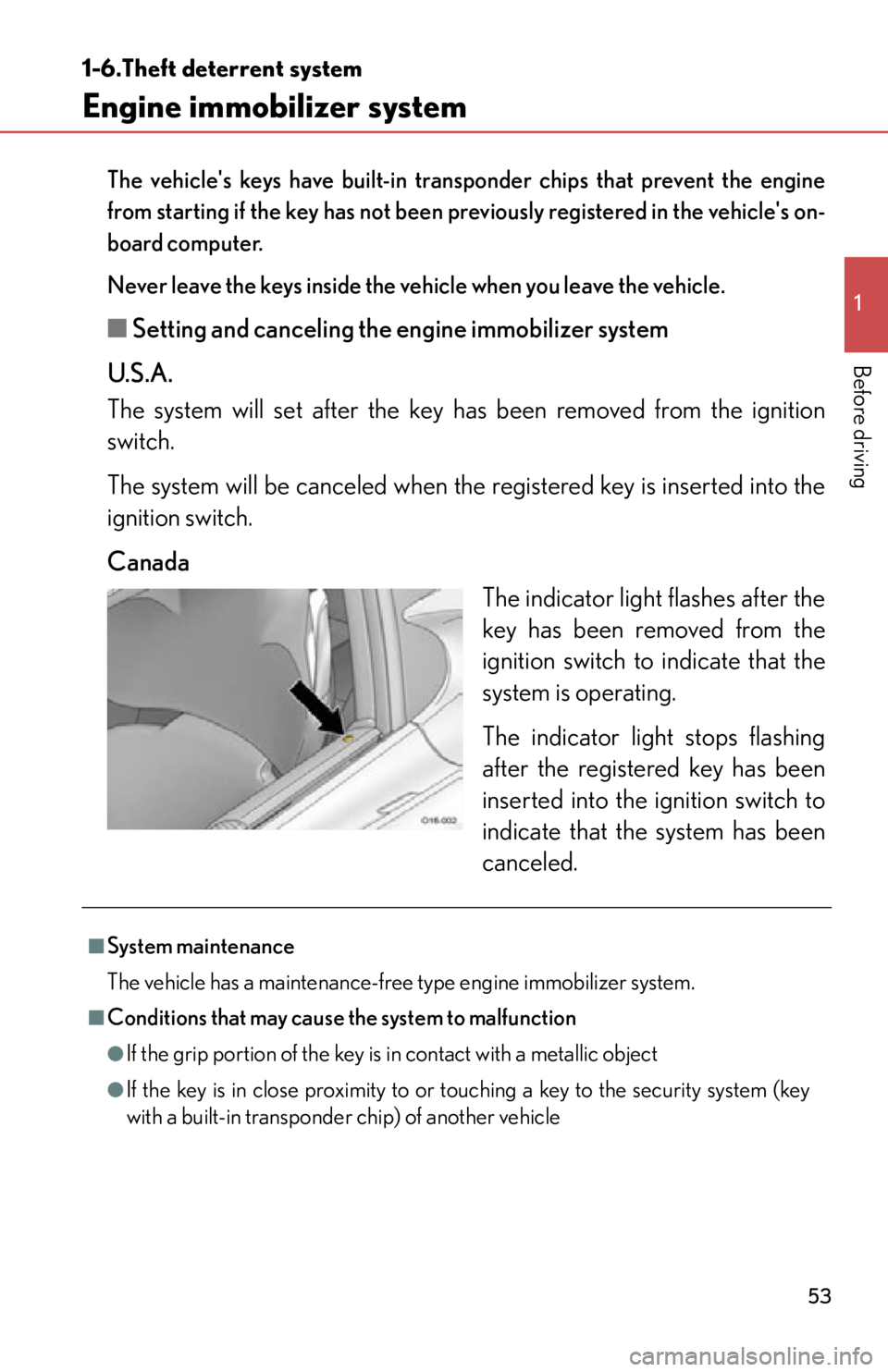Page 48 of 420
46
1-4.Opening and closing the windows
Power windows
The power windows can be opened and closed using the following switches.
Closing
One-touch closing
*
Opening
One-touch opening
*
*: Pushing the switch in the opposite
direction will stop window travel
partway.
■The power windows can be operated when
The ignition switch is in the “ON” position.
■Door lock linked window operation
●The power windows can be opened or closed using the key. (P. 2 5 )
●The power windows can be opened using the wireless remote control. ( P. 2 2 )
■Operating the power windows after turning the ignition switch off
The power windows can be operated for ap proximately 45 seconds even after the
ignition switch is turned to the “ACC” or “LOCK” position. They cannot, however,
be operated once either side door is opened.
■Jam protection function
If an object becomes caught between the window and the body, window travel is
stopped and the window is opened slightly.
Page 49 of 420

47
1-4. Opening and closing the windows
1
Before driving
■When the power window does not close normally
If the jam protection function is operating abnormally and a window cannot be
closed, perform the following operations using the power window switch on the rel-
evant door.
●After stopping the vehicle, the window can be closed with the door closed by
holding the power window switch in the one-touch closing position while the
ignition switch is turned to the “ON” position.
●If the window still cannot be closed even by carrying out the operation
explained above, initialize the function by performing the following procedure.
Hold the power window switch in the one-touch closing position. Con-
tinue holding the switch for a further 6 seconds after the window has
closed.
Hold the power window switch in the one-touch opening position. Con-
tinue holding the switch for a further 2 seconds after the window has
opened completely.
Hold the power window switch in the one-touch closing position once
again. Continue holding the switch for a further 2 seconds after the win-
dow has closed.
If you release the switch while the window is moving, start again from the beginning.
If the window continues to close but then re-open slightly even after performing the
above procedure correctly, have the vehicle inspected by your Lexus dealer.
■Customization that can be conf igured at your Lexus dealer
Settings of the linked key and wireless remote control operation can be changed.
(Customizable features P. 383)
STEP1
STEP2
STEP3
Page 52 of 420
50
1-5. Refueling
Closing the fuel tank capAfter refueling, turn the fuel tank
cap until you hear a click. Once
the cap is released, it will turn
slightly in the opposite direction.
■When the fuel filler door opener switch is inoperable
The lever can be used to open the fuel filler door if the fuel filler door cannot be
opened using the inside switch because th e battery is discharged or for any other
reason.
Open the rear hatch. ( P. 2 9 )
STEP1
Remove the cover.
Pull the lever.STEP2
STEP3
Page 55 of 420

53
1
Before driving
1-6.Theft deterrent system
Engine immobilizer system
The vehicle's keys have built-in transponder chips that prevent the engine
from starting if the key has not been previously registered in the vehicle's on-
board computer.
Never leave the keys inside the vehicle when you leave the vehicle.
■ Setting and canceling the engine immobilizer system
U.S.A.
The system will set after the key has been removed from the ignition
switch.
The system will be canceled when the registered key is inserted into the
ignition switch.
Canada
The indicator light flashes after the
key has been removed from the
ignition switch to indicate that the
system is operating.
The indicator light stops flashing
after the registered key has been
inserted into the ignition switch to
indicate that the system has been
canceled.
■System maintenance
The vehicle has a maintenance-free type engine immobilizer system.
■Conditions that may cause the system to malfunction
●If the grip portion of the key is in contact with a metallic object
●If the key is in close proximity to or touching a key to the security system (key
with a built-in transponder chip) of another vehicle
Page 57 of 420
55
1
1-6. Theft deterrent system
Before driving
Alarm
The system sounds the alarm and flashes the lights when forcible entry is
detected.
■ Triggering of the alarm
The alarm is triggered in the following situations when the alarm is set:
●A locked door is unlocked or op ened in any way other than using
the wireless remote control or key.
● The hood or rear hatch is opened.
● The tilt sensor detects a change of vehicle inclination.
■ Setting the alarm system
Close the doors, rear hatch and
hood, and lock both side doors.
The system will be set automati-
cally after 30 seconds.
The indicator light changes from
being on to flashing when the sys-
tem is set.
■Deactivating or stopping the alarm
Do one of the following to deactivate or stop the alarm.
●Unlock the doors.
● Start the engine. (The alarm will be deactivated or stopped after a
few seconds.)
Page 65 of 420
63
1-7. Safety information
1
Before driving
Airbag system componentsYour vehicle is equipped with AD VANCED AIRBAGS designed based
on US motor vehicle sa fety standards (FMVSS208). The airbag system
controls airbag deployment power for the driver and passenger. The
driver airbag system consist s of the driver’s seat position sensor etc. The
passenger’s airbag system consists of the passenger occupant classifica-
tion sensor etc. Passenger airbag
Seat belt airbag sensors
Occupant detection system
ECU
Occupant detection system
sensor
Seat belt buckle switches
Seat belt airbags
Airbag sensor assembly
Driver's seat position sensor
Driver’s knee airbag
Driver airbag
SRS warning light
“A I R B A G O N ” a n d “A I R
BAG OFF” indicator lights
Front airbag and seat belt air-
bag sensors
Page 66 of 420

64
1-7. Safety information
The main SRS airbag system components are shown above. The SRS air-
bag system is controlled by the airb ag sensor assembly. The airbag sen-
sor assembly consists of a safing sensor and an airbag sensor.
In certain types of severe frontal or side impacts, the SRS airbag system
triggers the airbag inflators. A chemica l reaction in the inflators quickly
fills the airbags with non-toxic gas to he lp restrain the motion of the occu-
pants.
■If the SRS airbags deploy (inflate)
●Bruising and slight abrasion s may result from contact with a deploying (inflating)
SRS airbag.
●A loud noise and white powder will be emitted.
●Parts of the airbag module (steering wheel , airbag cover and inflator) as well as
the seats may be hot for several minutes. The airbag itself may also be hot.
●The windshield may crack.
●For Safety Connect subscribers, if the SRS airbags deploy or in the event of a
severe rear-end collision, the system is designed to send an emergency call to
the response center, notifying them of the vehicle’s location (without needing to
push the “SOS” button) and an agent will attempt to speak with the occupants
to ascertain the level of emergency and assistance required. If the occupants
are unable to communicate, the agent automatically treats the call as an emer-
gency and helps to dispatch the necessary emergency services. ( P. 2 1 9 )
Page 70 of 420

68
1-7. Safety information
CAUTION
■SRS airbag precautions
Observe the following precautions regarding the airbags.
Failure to do so may cause death or serious injury.
●The driver and passenger in the vehicle must wear their seat belts properly.
The SRS airbags are supplemental devices to be used with the seat belts.
●The SRS driver airbag deploys with considerable force, and can cause death or
serious injury especially if the driver is very close to the airbag. The National
Highway Traffic Safety Administration (“NHTSA”) advises:
Since the risk zone for the driver airbag is the first 2 - 3 in. (50 - 75 mm) of infla-
tion, placing yourself 10 in. (250 mm) from your driver airbag provides you with a
clear margin of safety. This distance is measured from the center of the steering
wheel to your breastbone. If you sit less than 10 in. (250 mm) away now, you can
change your driving position in several ways:
• Move your seat to the rear as far as you can while still reaching the pedals
comfortably.
• Slightly recline the back of the seat. Although vehicle designs vary, many dr ivers can achieve the 10 in. (250 mm)
distance, even with the driver’s seat all the way forward, simply by reclining
the back of the seat somewhat. If reclining the back of your seat makes it hard
to see the road, raise yourself by using a firm, or raise the seat if your vehicle
has that feature.
• If your steering wheel is adjustable, ti lt it downward. This points the airbag
toward your chest instead of your head and neck.
The seat should be adjusted as recommended by NHTSA above, while still main-
taining control of the foot pedals, steering wheel, and your view of the instrument
panel controls.